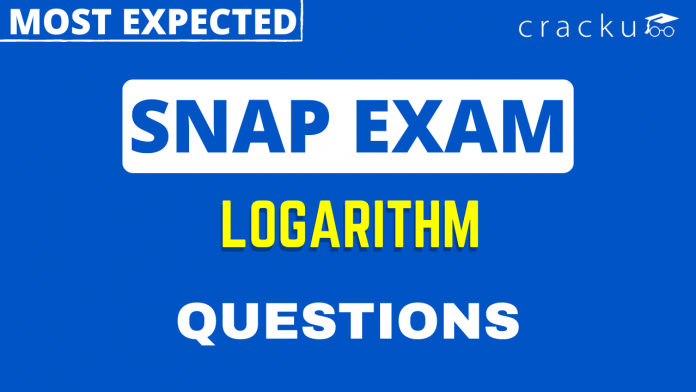Logarithm Questions for SNAP – Most Expected in Quant
The logarithm is an important topic in the Quant section of the SNAP Exam. Quant is a scoring section in SNAP, so it is advised to practice as much as questions from quant. This article provides some of the most important Logarithm Questions for SNAP. One can also download this Free Logarithm Questions for SNAP PDF with detailed answers by Cracku. These questions will help you practice and solve the Logarithm questions in the SNAP exam. Utilize this PDF practice set, which is one of the best sources for practising.
Download Logarithm Questions for SNAP
Enroll to SNAP 2022 Crash Course
Question 1: If $log_3 2, log_3 (2^x – 5), log_3 (2^x – 7/2)$ are in arithmetic progression, then the value of x is equal to
a) 5
b) 4
c) 2
d) 3
1) Answer (D)
Solution:
$2 log (2^x – 5) = log 2 + log (2^x – 7/2)$
Let $2^x = t$
=> $(t-5)^2 = 2(t-7/2)$
=> $t^2 + 25 – 10t = 2t – 7$
=> $t^2 – 12t + 32 = 0$
=> t = 8, 4
Therefore, x = 2 or 3, but $2^x$ > 5, so x = 3
Question 2: Let $u = ({\log_2 x})^2 – 6 {\log_2 x} + 12$ where x is a real number. Then the equation $x^u = 256$, has
a) no solution for x
b) exactly one solution for x
c) exactly two distinct solutions for x
d) exactly three distinct solutions for x
2) Answer (B)
Solution:
$x^u = 256$
Taking log to the base 2 on both the sides,
$u * \log_{2}{x} = \log_{2}{256}$
=>$[({\log_2 x})^2 – 6 {\log_2 x} + 12] * \log_{2}{x} = 8$
$(log_2 x)^3 – 6(log_2 x)^2 + 12log_2 x = 8$
Let $log_2 x = t$
$t^3 – 6t^2 +12t – 8 = 0$
$(t-2)^3 = 0$
Therefore, $log_2 x = 2$
=> $x = 4$ is the only solution
Hence, option B is the correct answer.
Question 3: If $log_y x = (a*log_z y) = (b*log_x z) = ab$, then which of the following pairs of values for (a, b) is not possible?
a) (-2, 1/2)
b) (1,1)
c) (0.4, 2.5)
d) ($\pi$, 1/ $\pi$)
e) (2,2)
3) Answer (E)
Solution:
$log_y x = ab$
$a*log_z y = ab$ => $log_z y = b$
$b*log_x z = ab$ => $log_x z = a$
$log_y x$ = $log_z y * log_x z$ => $log x/log y$ = $log y/log z * log z/log x$
=> $\frac{log x}{log y} = \frac{log y}{log x}$
=> $(log x)^2 = (log y)^2$
=> $log x = log y$ or $log x = -log y$
So, x = y or x = 1/y
So, ab = 1 or -1
Option 5) is not possible
Question 4: If x >= y and y > 1, then the value of the expression $log_x (x/y) + log_y (y/x)$ can never be
a) -1
b) -0.5
c) 0
d) 1
4) Answer (D)
Solution:
$log_x (x/y) + log_y (y/x)$ = $1 – log_x (y) + 1 – log_y (x)$
= $2 – (log_x y + 1/log_x y)$ <= 0 (Since $log_x y + 1/log_x y$ >= 2)
So, the value of the expression cannot be 1.
Question 5: If $f(x) = \log \frac{(1+x)}{(1-x)}$, then f(x) + f(y) is
a) $f(x+y)$
b) $f{\frac{(x+y)}{(1+xy)}}$
c) $(x+y)f{\frac{1}{(1+xy)}}$
d) $\frac{f(x)+f(y)}{(1+xy)}$
5) Answer (B)
Solution:
If $f(x) = \log \frac{(1+x)}{(1-x)}$ then $f(y) = \log \frac{(1+y)}{(1-y)}$
Also Log (A*B)= Log A + Log B
f(x)+f(y) = $ \log \frac{(1+x)(1+y)}{(1-x)(1-y)}$
=$\log\frac{\left(1+xy\ +x\ +y\right)}{\left(1+xy-x-y\right)}$
Dividing numberator and denominator by (1+xy)
$\log\frac{\frac{\left(1+xy\ +x\ +y\right)}{1+xy}}{\frac{\left(1+xy-x-y\right)}{1+xy}}$
=$\log\frac{\frac{1+xy\ }{1+xy}+\frac{\left(x+y\right)}{1+xy}}{\frac{1+xy\ }{1+xy}-\frac{\left(x+y\right)}{1+xy}}$
= $\log { \frac{1+ \frac{(x+y)}{(1+xy)}}{1- \frac{(x+y)}{(1+xy)}}}$
Hence option B.
Take SNAP mock tests here
Enrol to 10 SNAP Latest Mocks For Just Rs. 499
Question 6: If $\log_{2}{\log_{7}{(x^2 – x+37)}}$ = 1, then what could be the value of ‘x’?
a) 3
b) 5
c) 4
d) None of these
6) Answer (C)
Solution:
$\log_{2}{\log_{7}{(x^2 – x+37)}}$ = 1
$\log_{7}{(x^2 – x+37)}$ = $2$
$(x^2 – x+37)$ = $7^{2}$
Given eq. can be reduced to $x^2 – x + 37 = 49$
So x can be either -3 or 4.
Question 7: If $\log_{2}{x}.\log_{\frac{x}{64}}{2}=\log_{\frac{x}{16}}{2}$. Then x is
a) 2
b) 4
c) 16
d) 12
7) Answer (B)
Solution:
$\log_{2}{x}.\log_{\frac{x}{64}}{2}=\log_{\frac{x}{16}}{2}$
i.e. $\frac{log{x}}{log{2}} * \frac{log_{2}}{log{x}-log{64}} = \frac{log{2}}{log{x}-log{16}}$
i.e. $\frac{log{x} * (log{x}-log{16})}{log{x}-log{64}}$ = $\log{2}$
let t = log x
Therefore, $\frac{t * (t-log{16})}{t-log{64}}$ = $\log{2}$
$t^2-4*log 2*t = t*log 2-6*(log 2)^2$
I.e. $t^2-5*log 2*t-6*(log 2)^2$ = 0
I.e. $t^2-3*log 2*t-2*log 2*t-6*(log 2)^2$ = 0
i.e. $t*(t-3*log 2)-2*log 2*(t-3*log 2)$ = 0
i.e $t=2*log 2$ or $t=3*log 2$
i.e $log x=log 4$ or $log x=log 8$
therefore $x=4$ or $8$
therefore our answer is option ‘B’
Question 8: What is the value of $\sqrt{\frac{a}{b}}$, If $\log_{4}\log_{4}4^{a-b}=2\log_{4}(\sqrt{a}-\sqrt{b})+1$
a) -5/3
b) 2
c) 5/3
d) 1
8) Answer (C)
Solution:
$\sqrt{\frac{a}{b}}$, If $\log_{4}\log_{4}4^{a-b}=2\log_{4}(\sqrt{a}-\sqrt{b})+\log_{4}{4}$
i.e. $\log_{4}\log_{4}4^{a-b}=\log_{4}((\sqrt{a}-\sqrt{b})^2)*4$
i.e. $\log_{4}4^{a-b}=((\sqrt{a}-\sqrt{b})^2)*4$
i.e. (a-b)*$\log_{4}4=((\sqrt{a}-\sqrt{b})^2)*4$
i.e. a-b = 4a+4b-8$\sqrt{ab}$
i.e. 3a + 5b – 8$\sqrt{ab}$ = 0
i.e. $3\sqrt\frac{a}{b}^2$ – 8$\sqrt\frac{a}{b}$+5 = 0
put $\sqrt\frac{a}{b}$ = t
therefore 3$t^2$ – 8t + 5 = 0
solving we get t = 1 or t = $\frac{5}{3}$
i.e. $\sqrt\frac{a}{b}$ = 1 or $\frac{5}{3}$
but if $\sqrt\frac{a}{b}$ = 1 then a=b then $\log_{4}(\sqrt{a}-\sqrt{b})$ will become indefinite
Therefore $\sqrt\frac{a}{b}$ = $\frac{5}{3}$
Therefore our answer is option ‘C’
Question 9: $\log_{5}{2}$ is
a) An integer
b) A rational number
c) A prime number
d) An irrational number
9) Answer (D)
Solution:
Let $\log_{5}{2}$ = y
Let us assume $\log_{5}{2}$ is a rational number.
$\log_{5}{2}$ = p/q, where p and q are co primes.
5^(p/q)=2 => 5^p=2^q.
5^p=5*5*5*5*5*5*5………………p times
2^p=2*2*2*2*2*2*2………………q times
No value of p and q can satisfy the equation. Hence y is an irrational number.
Question 10: Find the value of x from the following equation:
$\log_{10}{3}+\log_{10}(4x+1)=\log_{10}(x+1)+1$
a) 2/7
b) 7/2
c) 9/2
d) None of the above
10) Answer (B)
Solution:
$\log_{10}{3}+\log_{10}(4x+1)=\log_{10}(x+1)+1$ can be written as
$\log_{10}{3}+\log_{10}(4x+1)=\log_{10}(x+1)+\log_{10}{10}$
We know that $\log_{10}{a}+\log_{10}{b}=\log_{10}{ab}$
$\log_{10}{3*(4x+1)}=\log_{10}{(x+1)*10}$
$12x+3=10x+10$
$x=7/2$. Hence, option B is the correct answer.





